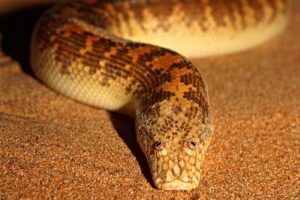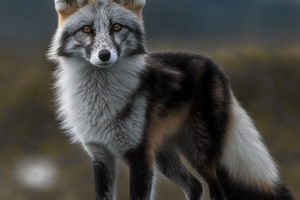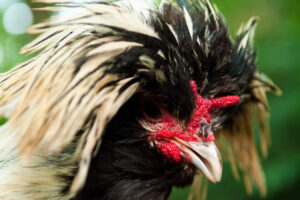In wetlands along the coast of southern California, tiny sperm-like larvae swim in search of a host. When a killifish gets close, the larvae rush to the fish and force their way through it at full speed. Inside the fish, they travel through the bloodstream and nerves up to the brain, which they cover with thousands of tiny vesicles.
This causes the fish to reach the surface and splash there, but then the probability that it will end up in the stomach of a bird of prey increases significantly – exactly what the parasite wants, because that is where it plans to lay its eggs.
This takeover of the fish brain by the parasite is just one example of the parasites’ sinister tactics. Nevertheless, a large international team of scientists led by American experts is now working on a rescue plan designed to protect the brain parasite and thousands of other parasites.
Extensive research to save parasites
Scientists only know about a tenth of parasites. This requires extensive action to improve. Besides identifying endangered parasites, the project aims to educate us about their importance.
1. Data collection
Identification of parasites in different ecosystems and mapping of DNA and behavior.
2. Processing of the selection list
Sort the parasites according to how dangerous they are.
3. Description of species
Scientific definition of half of all parasites.
4. Statutory Protection
Legislators pass legislation that protects parasites.
5. Teaching
Better education for scientists and students about parasites.
6. Risk analysis
Mapping which species are most at risk and what causes it.
7. Education
Inform the public about the role of parasites in nature.
Just like a large part of the world’s nicer animal species, many parasites are in danger of becoming extinct .
And although it seems like the best thing to do in a world without parasites, their disappearance can have serious consequences for the world’s ecosystems and biodiversity.
This project still does not receive sufficient financial support. Parasites are overshadowed by the other challenges of climate change and declining biodiversity, and a rescue plan for these tiny creatures may be the last thing on people’s minds.
But the experts behind this operation are convinced that parasites are an invaluable weapon in the fight against many other problems facing nature.
Namely, they play a key role when it comes to keeping ecosystems in a fair balance.
All living things have parasites
Parasites are organisms that live either inside or outside of another organism and need their host to survive.
Parasites range from tiny particles such as protozoa, bacteria and viruses, to animals such as worms, lice and mites. Plants can also be parasitic, such as mistletoe, which grows on trees and burrows its roots into them to suck up nutrient-rich fluids.
Climate change threatens the parasites
Parasites are everywhere in nature and the largest groups include lice, worms and mites. Climate change threatens a large part of them, which will reduce biodiversity.
Parasites have in common that they make the most of their hosts and have extremely clever ways to infect and feed on them.
Some castrate the hosts, others trick them into changing their behavior, and many manipulate the hosts’ behavior so that they behave as the parasite wishes.
While the parasite’s existence is determined by the host, the host does not benefit from the parasite. On the contrary, parasites often result in infections and the host becomes weak.
The parasites rarely benefit from killing their hosts, but if the host is infected with many parasites at the same time or is only the only intermediary to another host, this symbiosis can end with the death of the host.
This method is truly terrifying but very effective. Parasites are probably the group of animals with the most species.
All ecosystems on Earth contain parasites, and all other animals on Earth are infected by them in one way or another.
Scientists estimate that parasites make up 30-50% of all species on Earth. However, a detailed overview of their distribution is not available, as they only live inside other organisms.
Probably only about a tenth of parasite species have been identified so far.
Parasites are the heroes of the food chain
It appears that parasites can be unpleasant for the host and that most scientists fight against them.
But despite the fact that parasites exploit their hosts and cause disease in animals and humans, they play an extremely important role in ecosystems of all kinds in the larger context.
Parasites control the population size of their hosts in their own way and set in motion a kind of domino effect that affects other species, for example the host’s natural predators or its prey.
Therefore, they have a great influence in the food chain. Research has shown that 75% of all links in nature’s food chain are parasites, and despite the fact that many parasites are tiny, their combined biomass is enormous.
A study of the biomass of species in ecosystems along the coast of California showed that the biomass of the parasites is greater than that of the top predators in the food chain.
Scientists estimate that parasites make up about 30 – 50% of all species on Earth.
In many ecosystems, parasites are important food for other species. On the islands of the Gulf of California, many predators, such as tetrapods, spiders and scorpions, are up to half as many in places where shorebird populations are strong.
This was caused by the animals eating parasites that sit on the birds, especially catfish and fleas. The same principle is found in the ocean where shrimp and fish feast on parasites that infect many species.
When parasites end up on the menu, it’s not always a coincidence, though. In many cases, it is actually their goal to be eaten so that they can enter another host and proceed to the next stage of their life cycle.
To this end, they have developed an incredible variety of abilities to manipulate their host and change its behavior so that it is more vulnerable to being eaten by a predator.
On the seabed, for example, shrimp are infected with a whipworm, which causes them to move faster and thus increases the risk of skates eating the shrimp.
Some worms force insects to drown themselves, so that the worms can lay their eggs in the water. And it is said to infect frogs, which cause them to grow extra limbs, but this makes them much less able to escape from predators.
A brain parasite controls fish
Some parasites go through complex life cycles that require them to move between multiple hosts. This is the case, for example, with the snake Euhaplorchis californiensis, which, like a brilliant manager, gets shorebirds, snails and fighting fish to play together. When the parasite reaches the brain of the fish, it becomes easy prey for the birds and thus the parasite plays a role in keeping the population size of the fish in balance.
What these manipulative parasites have in common is that they control the population size of their hosts and thus also the predators and prey that the hosts encounter.
Without such parasites to hold back populations of other animals, some species could grow rampant at the expense of other organisms. For example, the killifish is the most widespread fish species in the wetlands along the coast of California.
The stingray Euhaplorchis californiensis attacks the brains of the fish and causes them to seek the surface and into the gills of shorebirds.
This prevents the fish population from growing uncontrollably with dire consequences for the entire ecosystem. The parasite thus balances the food chain, which benefits both the fish’s prey – small shrimp – and the birds.
Other parasites act on population sizes in other and incredibly efficient ways. Instead of controlling the host and its behavior, they castrate the host to take advantage of its potential and thus cut a significant gap in the future generations of the species.
Pandas steal the spotlight
While there are repeated calls to save animals such as bees, tigers, elephants and pandas from extinction, not much is said about the parasites.
Some scientists fear that although parasites make up the largest number of species, there are many threats to their existence. Thousands or millions of parasites feel the negative effects of climate change and declining biodiversity.
The problem is that experts do not know much about the life of the parasites, nor how climate change affects them.
Experts in the field still disagree about how parasites will respond to these changes. Some believe that they, like many other species on the planet, are in great danger as their hosts disappear one by one.
Others believe that weakened ecosystems will reduce the vigor of many hosts and make them more vulnerable to infection by parasites.
To gain better insight into how changes in diversity affect the number of parasite species, a group of American scientists – who are also involved in the rescue program – set up a large-scale experiment in ponds near San Francisco Bay.
In half of the ponds, the experts installed birdhouses and various other things to attract birds. In this way, the ecosystem was slightly changed and the number of species increased.
75% of all links in the food chain are parasites.
After a few years, the scientists analyzed the diversity of parasites in these ponds. The result was not uniform, because while the number of some species decreased due to the increased diversity of birds, others flourished.
The scientists concluded that changes in the diversity of organisms, for example due to climate change, will thus affect parasites in different ways – even among species in the same ecosystem. Th
Both theories hold sway among parasite experts: Parasites can both thrive and decline as a result of changes in ecosystem diversity.
The next step is to find out which factors are most important here.
Map the parasites
The rescue plan consists of twelve objectives which are divided into four main categories: data collection, assessment of the surrounding danger, protection and education.
One of the most important goals is to gain a better knowledge of these countless species. One of the most ambitious goals is for scientists to identify and scientifically describe half of all parasites on the planet within the next ten years.
Video: A worm crawls around in the eye
Numerous unwanted parasites attack humans. One of the most disgusting is the African eye worm Loa loa, which enters the body through a mosquito bite. The worms can travel under the skin for many years, reaching the penis, testicles, nipples, kidneys, heart and even into the eye.
Considering that only about 10% of all species have been identified to date, this is a huge task, but not impossible. According to experts, you just need to prioritize within research in biology.
When biologists now study the biodiversity of regions, parasites are rarely included in that calculation, and the scientists want to change this.
In addition, they intend to collect a huge amount of data in digital libraries, where the information will be more accessible.
Knowledge of all these species is fundamental to the rescue plan. In order for experts to assess the degree of danger to individual species and initiate appropriate rescue measures, it is necessary to identify and describe their life cycle and role in the ecosystem.
10% of all parasites have been mapped. Five times the number in the next decade.
One method consists of so-called DNA barcoding.
This method involves using the unique DNA characteristic of a species to monitor it in a specific area.
In this way, they can gain insight into the role and life cycle of parasites by analyzing soil, air or water samples and do not have to capture the animals.
Knowledge of animal genetics is one important factor in gaining an understanding of these organisms.
All information will then be used to assess which parasites are most at risk and what the consequences of their death could be.
Scientists will also be better able to assess whether the parasites are in as much danger as their hosts.
At first, actions that protect the hosts may thus also help parasites; for example, with regard to the protofasciola robusta that thrives in the intestines of elephants, but scientists also intend to implement targeted measures for the parasites.
In order to gain an overview of the danger to the species, parasites will be arranged on a special list, where the species’ progress will be assessed.
But before the rescue work can begin, the parasites’ reputation needs to be improved. That should happen, among other things, with more teaching and training of both students and scientists in ecology and nature conservation. But it is not only educated people who should know the parasites better.
The aim is to better inform the public about how amazing the parasites are with the help of the media.
If people generally realize how important the parasites are in the food chain, it will be easier to ensure adequate rescue operations.
Parasites make humans healthier
To avoid resistance to these rescue efforts, experts have preemptively ruled out parasites that infect humans.
But in fact, there are many indications that the disappearance of some species could prove to be costly for humans.
Research has shown, for example, that infections caused by parasites at a young age reduce the likelihood that the person will develop autoimmunity later in life.
This explains why we in the western world, where such infections have been greatly reduced, are increasingly exposed to autoimmune diseases. In the last two decades, scientists have discovered that parasites reduce symptoms such as allergies, asthma and intestinal infections .
Parasites benefit humans
As far as the host is concerned, parasites are usually unwelcome guests. Some parasites attack humans, as they can cause a variety of sufferings, just like the fluke did in this country in the olden days. A new study shows that parasites can also cure diseases, such as intestinal infections and asthma.
Whipworms prevent intestinal infection
In areas of the world where intestinal parasites are widespread, inflammatory diseases such as Crohn’s disease are rare. Now scientists have found the explanation. One cause of Crohn’s disease is harmful gut flora. Experiments on mice show that the presence of whipworms in the intestines allows the good bacteria to get the upper hand in the fight against the harmful ones. In this way, whipworms indirectly reduce infections.
Hookworms clear the airways
Parasites may be useful in the treatment of asthma. Experts have identified a protein secreted by the worms, which is promising. The protein AIP-2 reduces both inflammation and infections in the respiratory system of mice and reduces the response of the immune system. It is precisely an overactive immune system that increases mucus production in tuberculosis and alveoli, but this reduces air flow and damages shortness of breath.
Among other things, these diseases have in common that the person’s immune system is overactive. For example, parasites have developed methods to reduce the activity of the immune system by secreting substances that calm the immune cells and reduce the secretion of substances that can cause infections.
In the long run, the health of the planet’s organisms will deteriorate if the parasites are eliminated. Parasites are thus not just scary creatures – they are a necessary part of a healthy world.


















